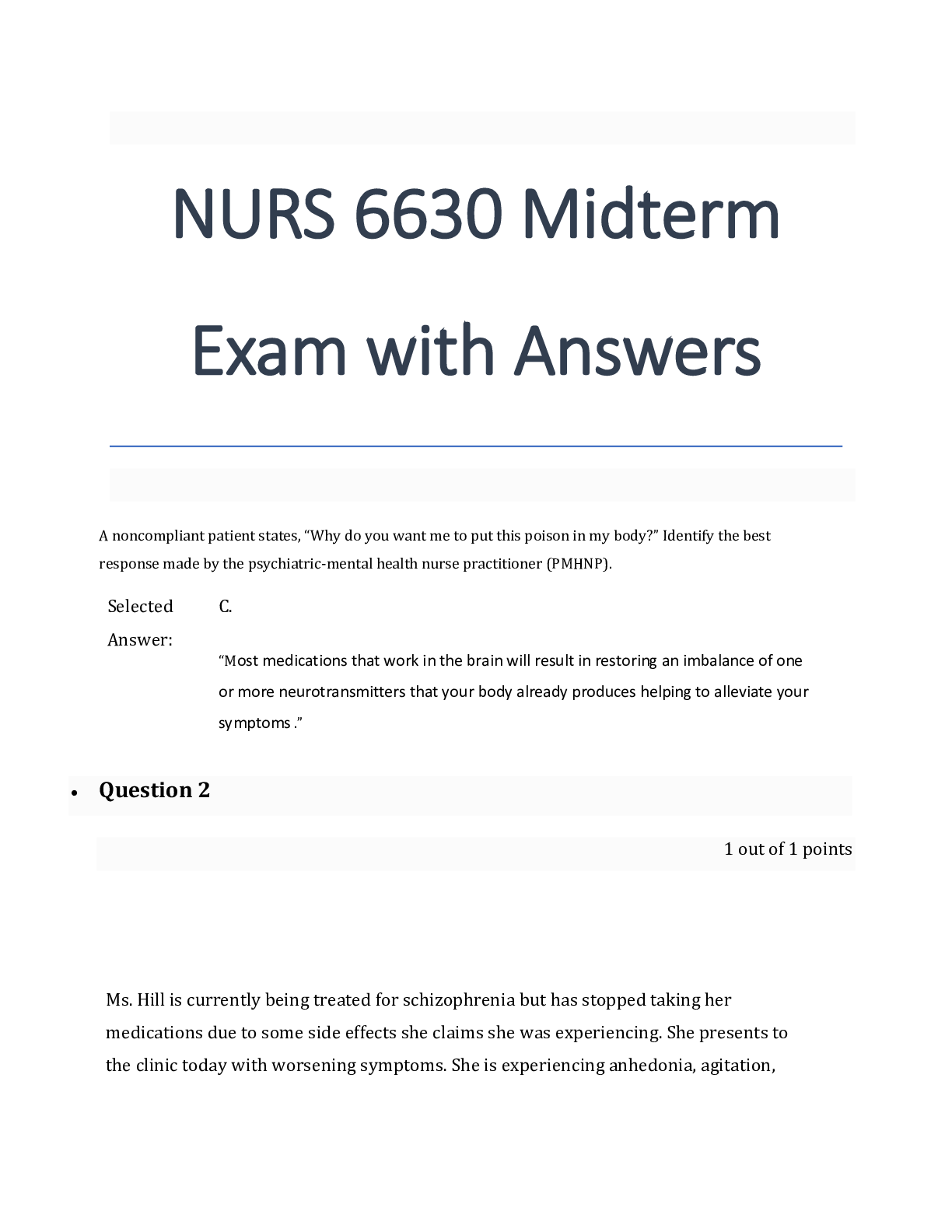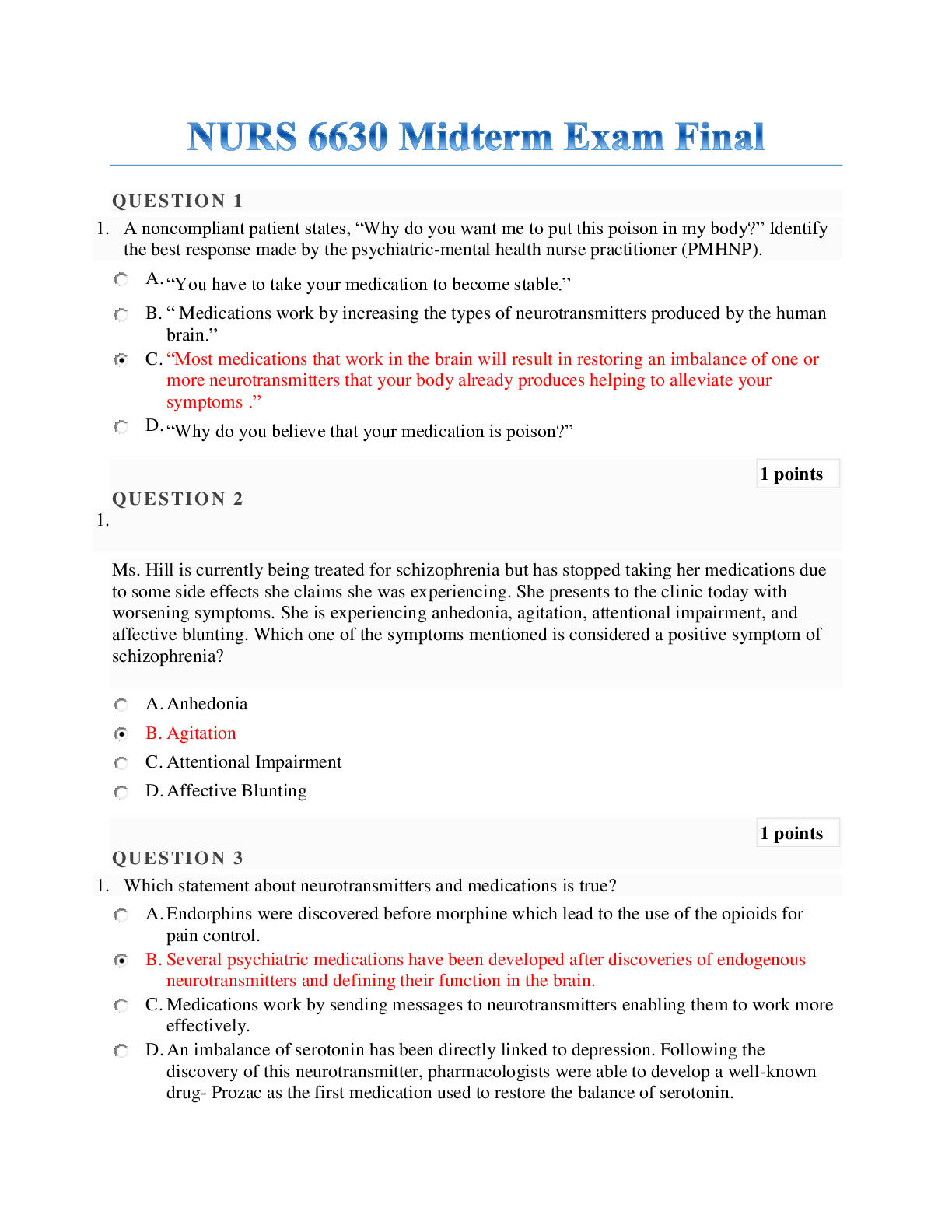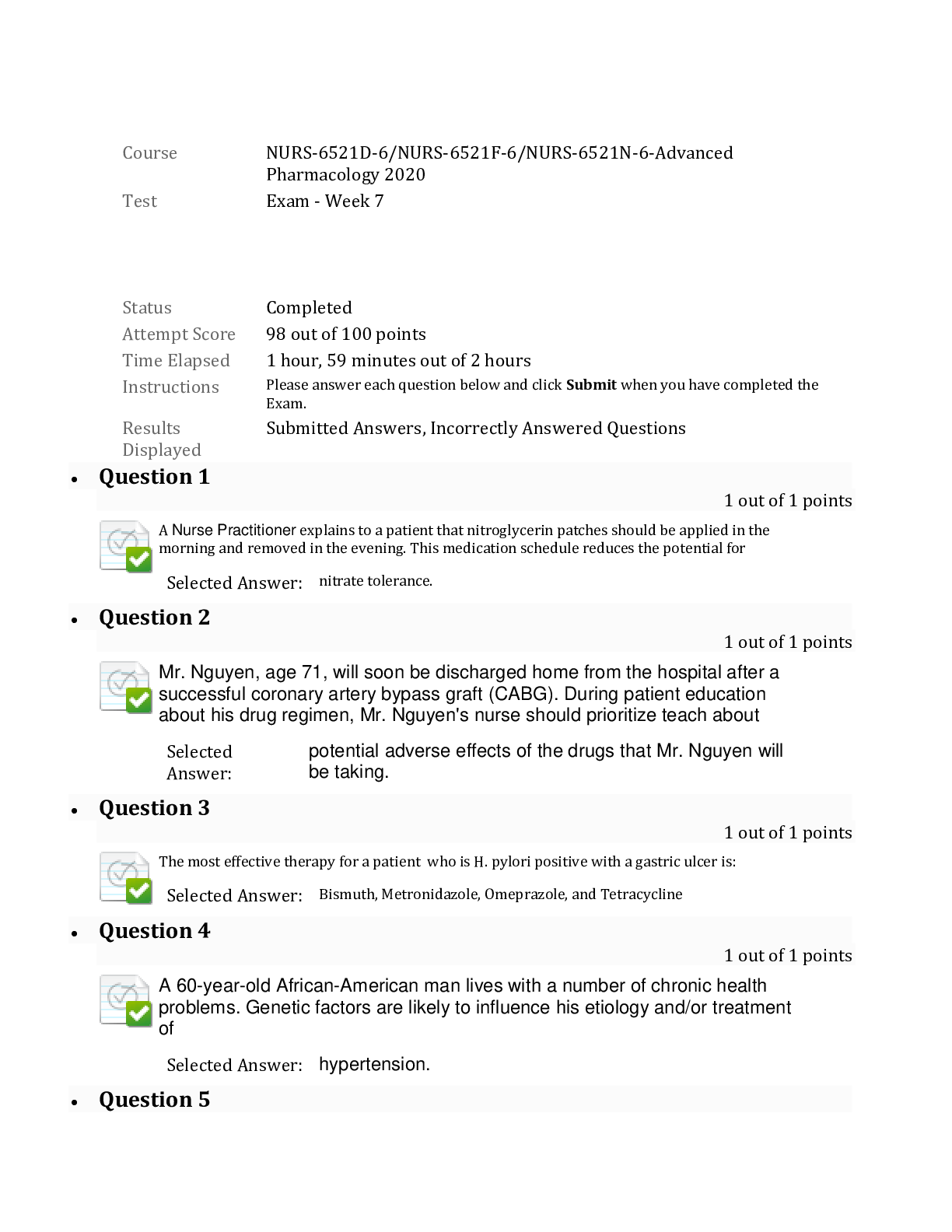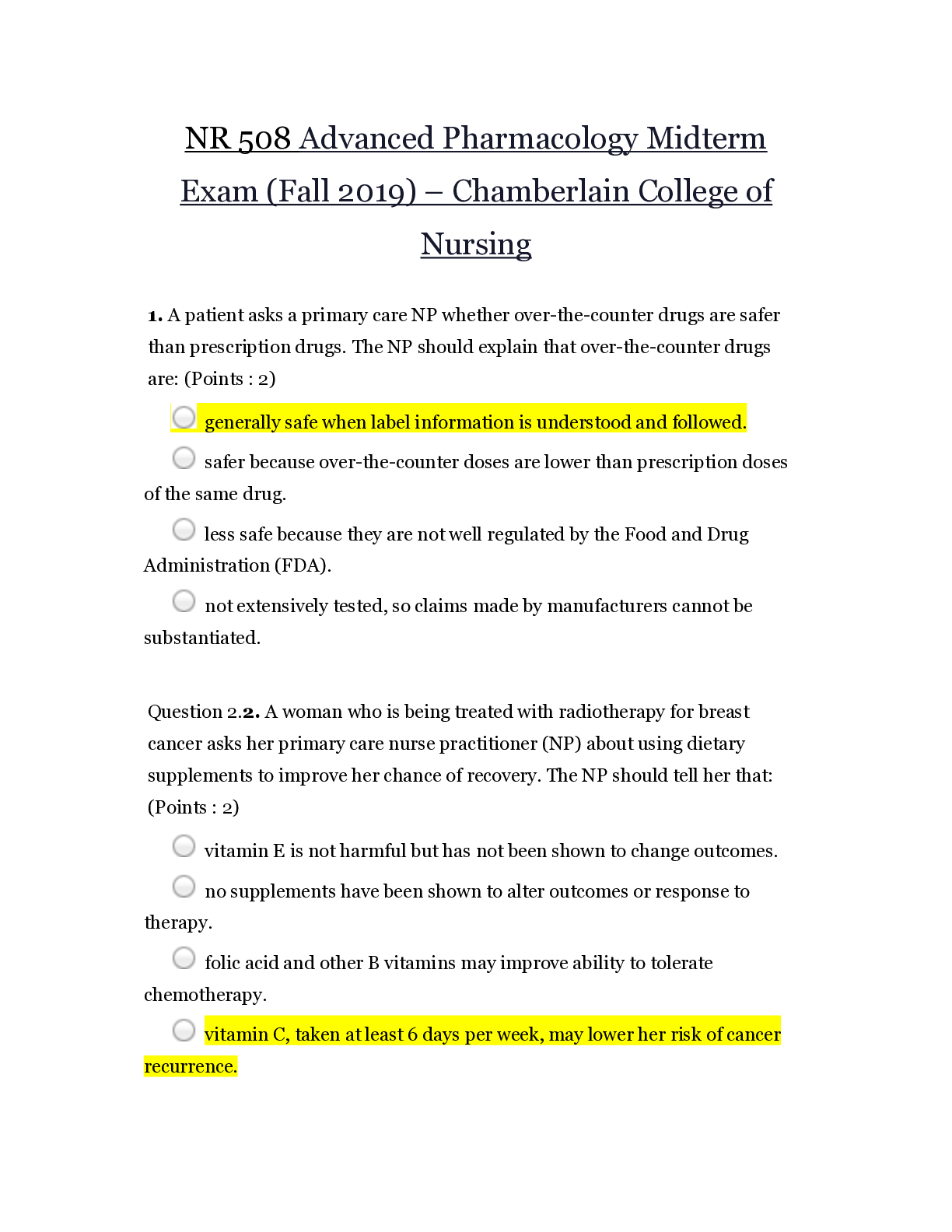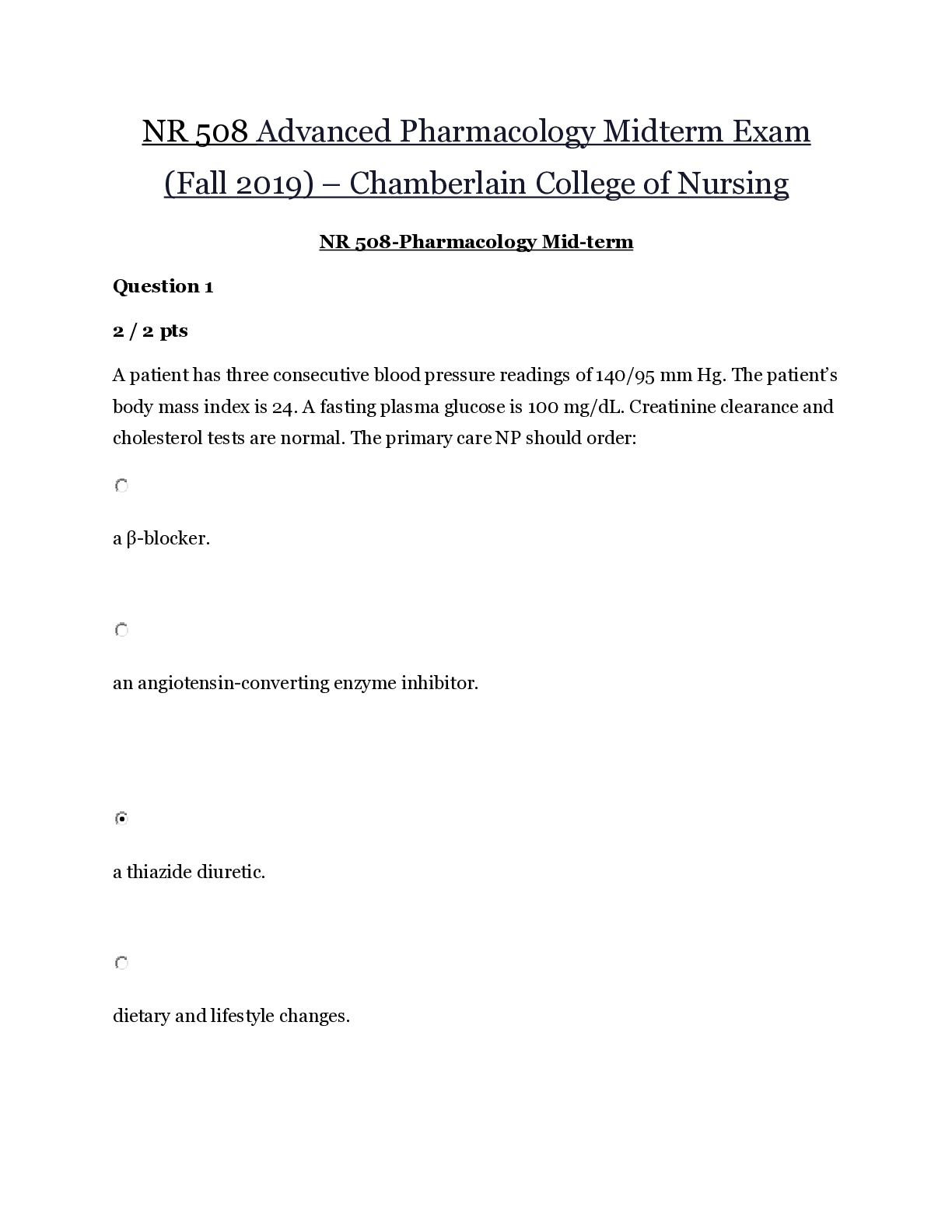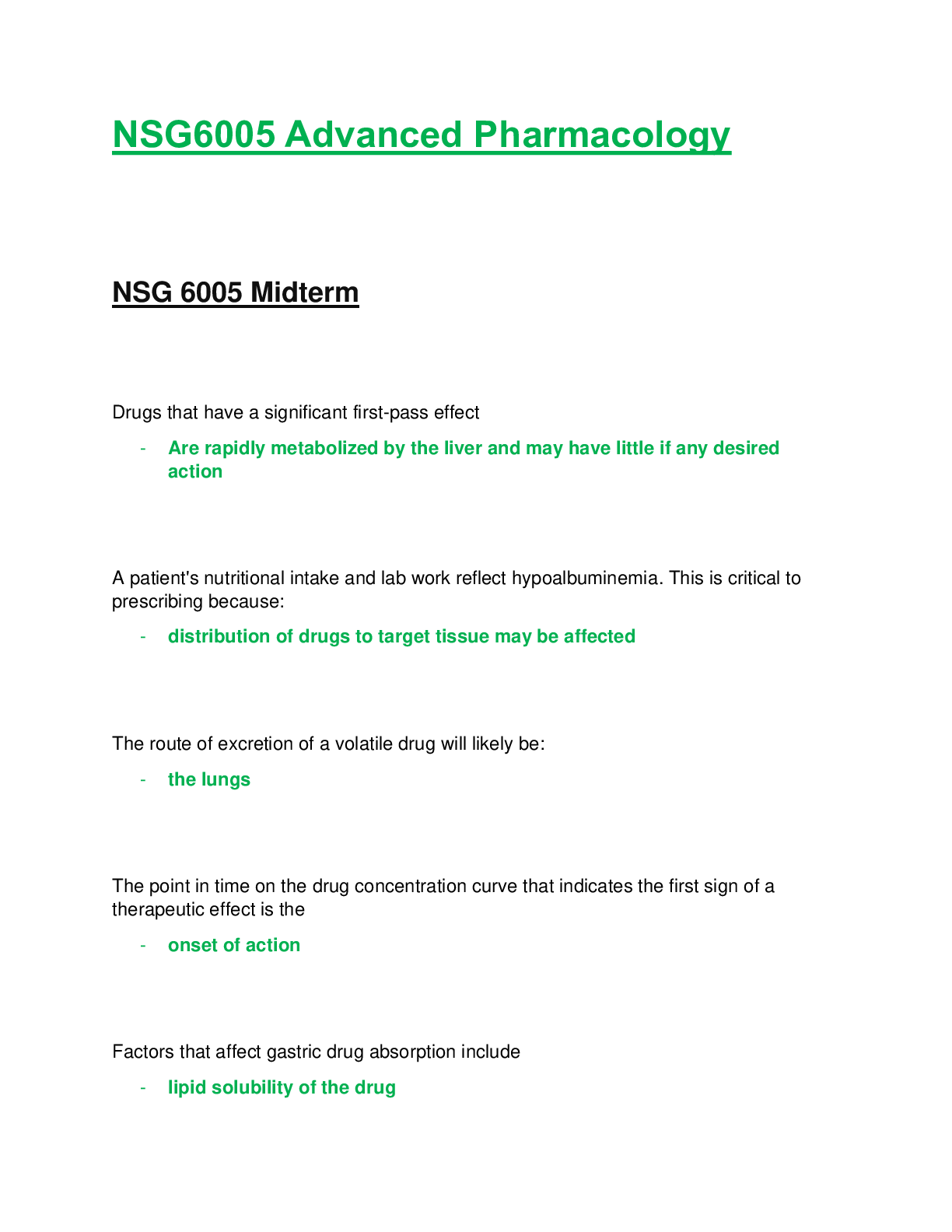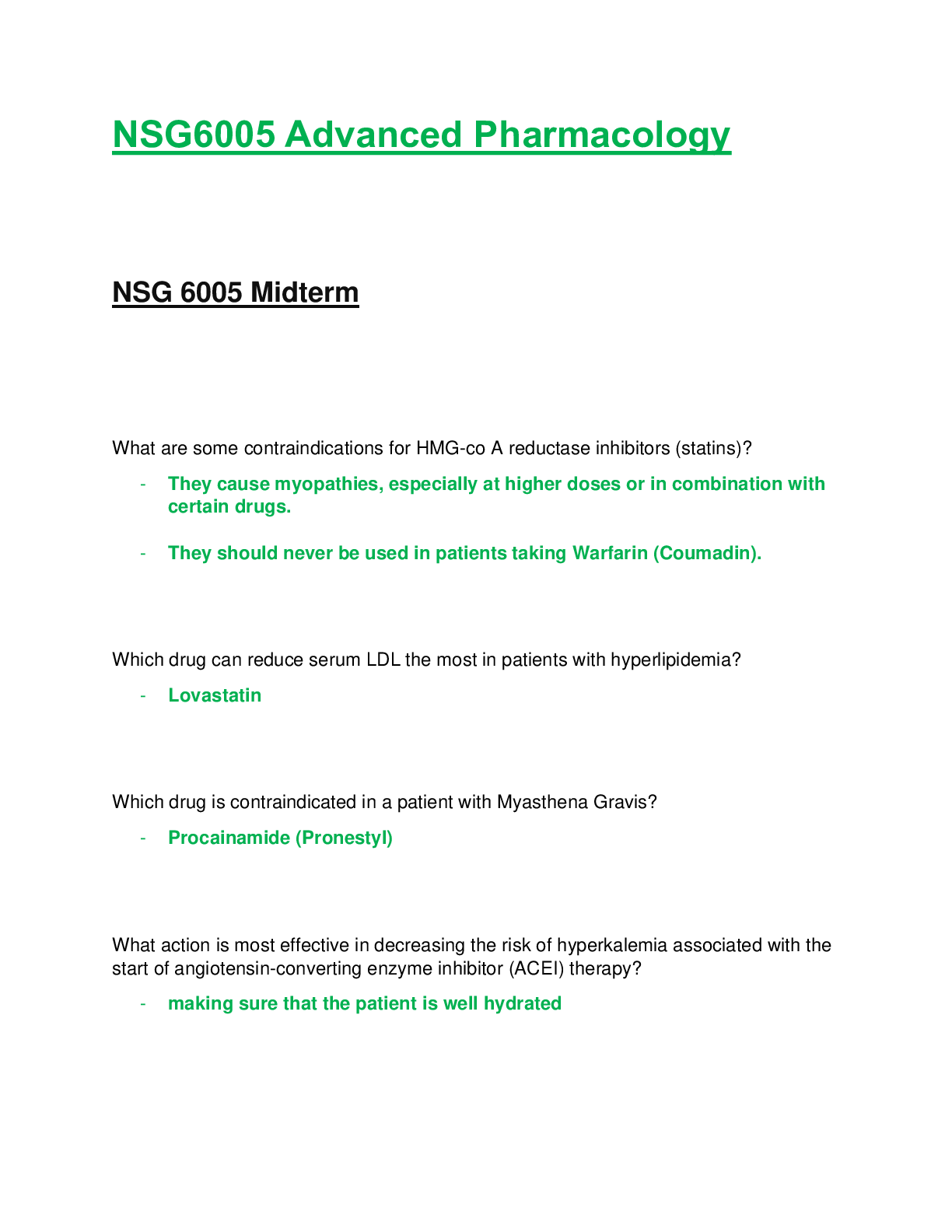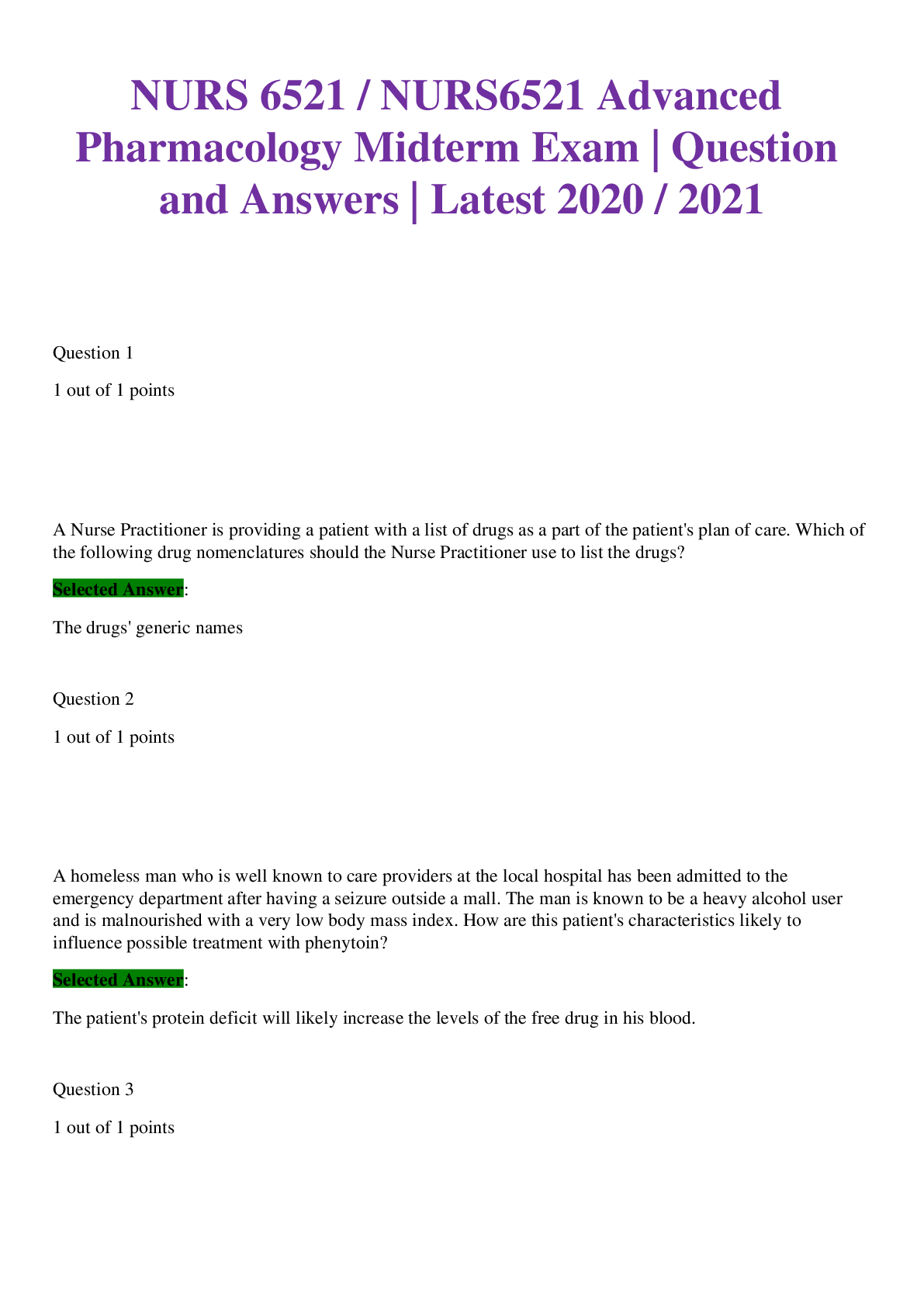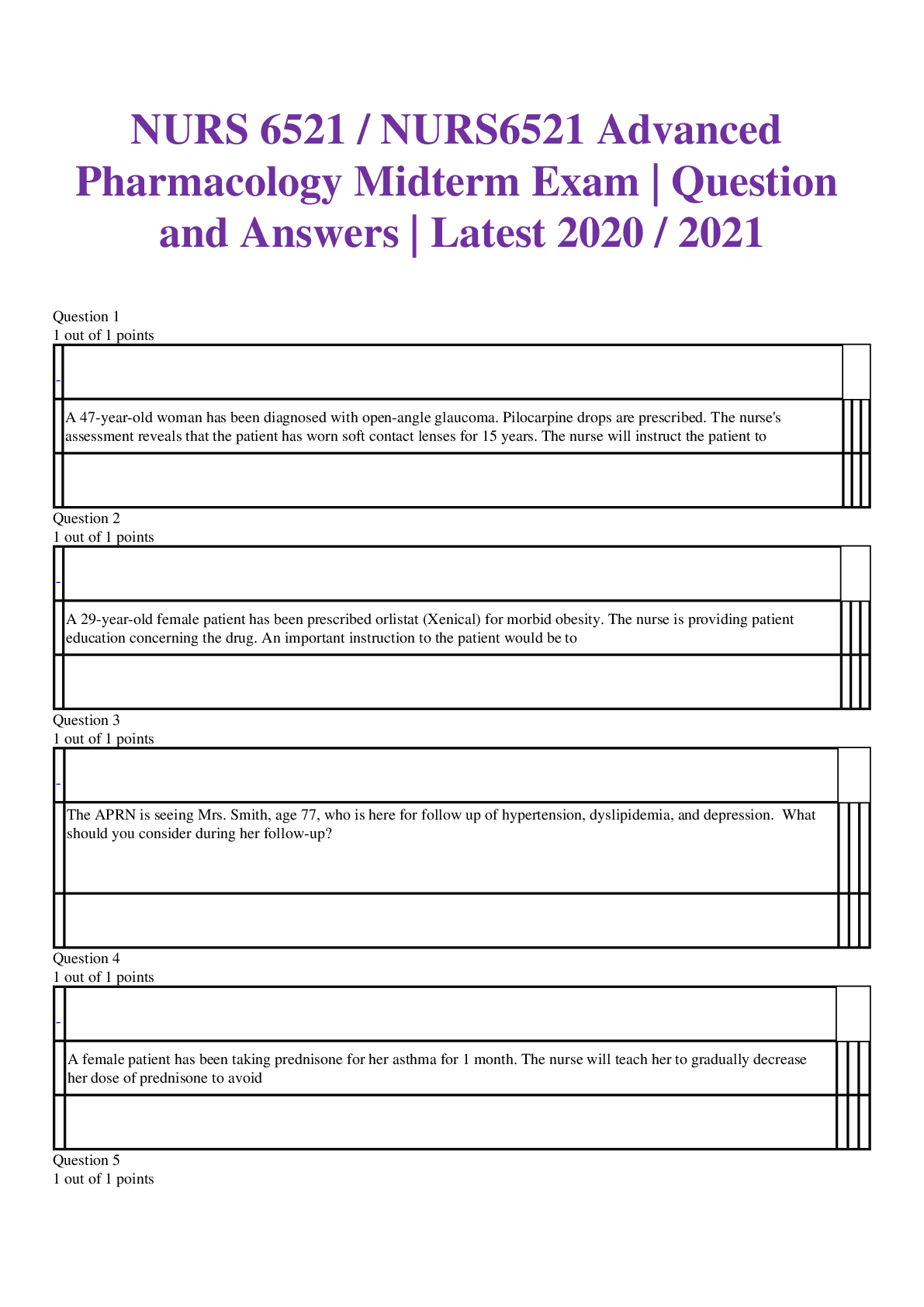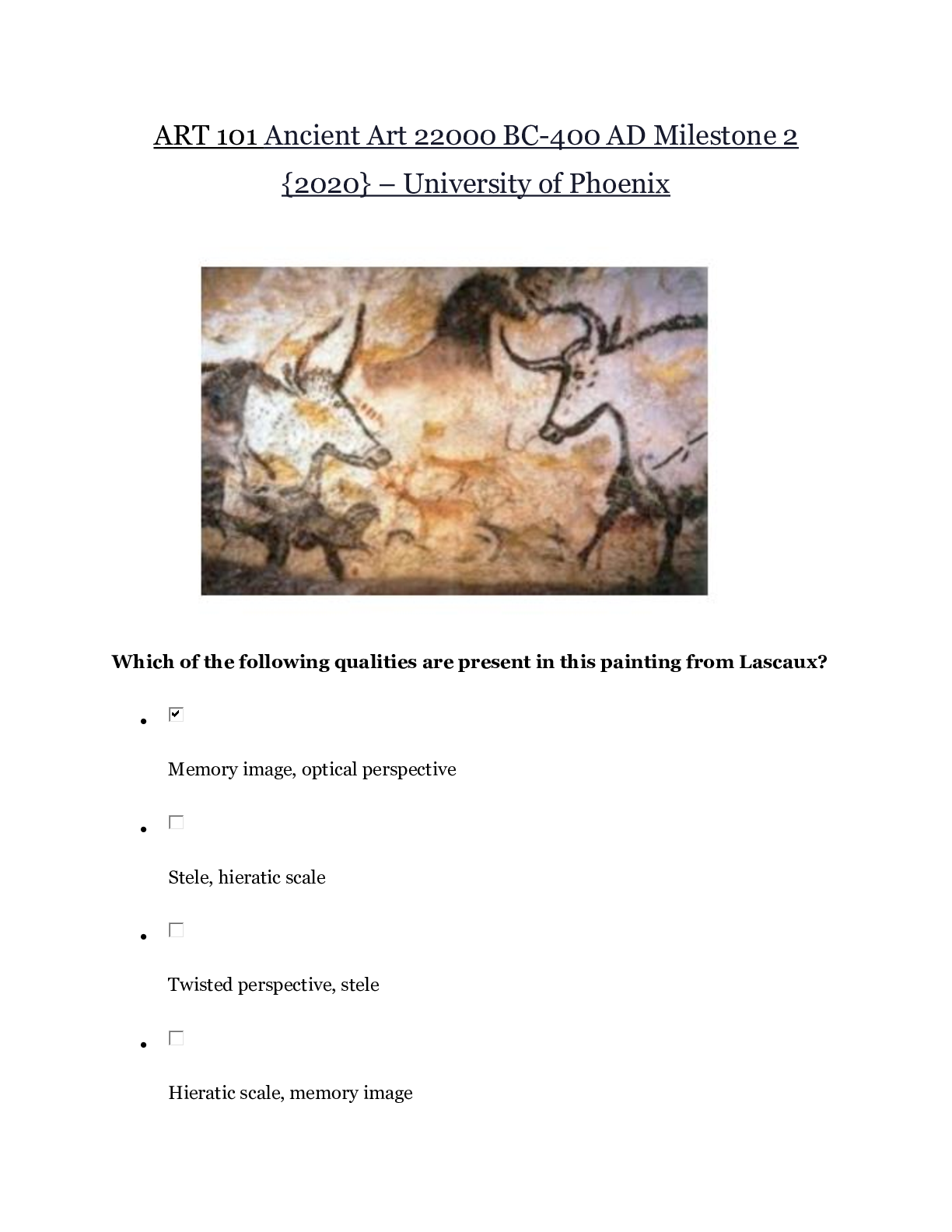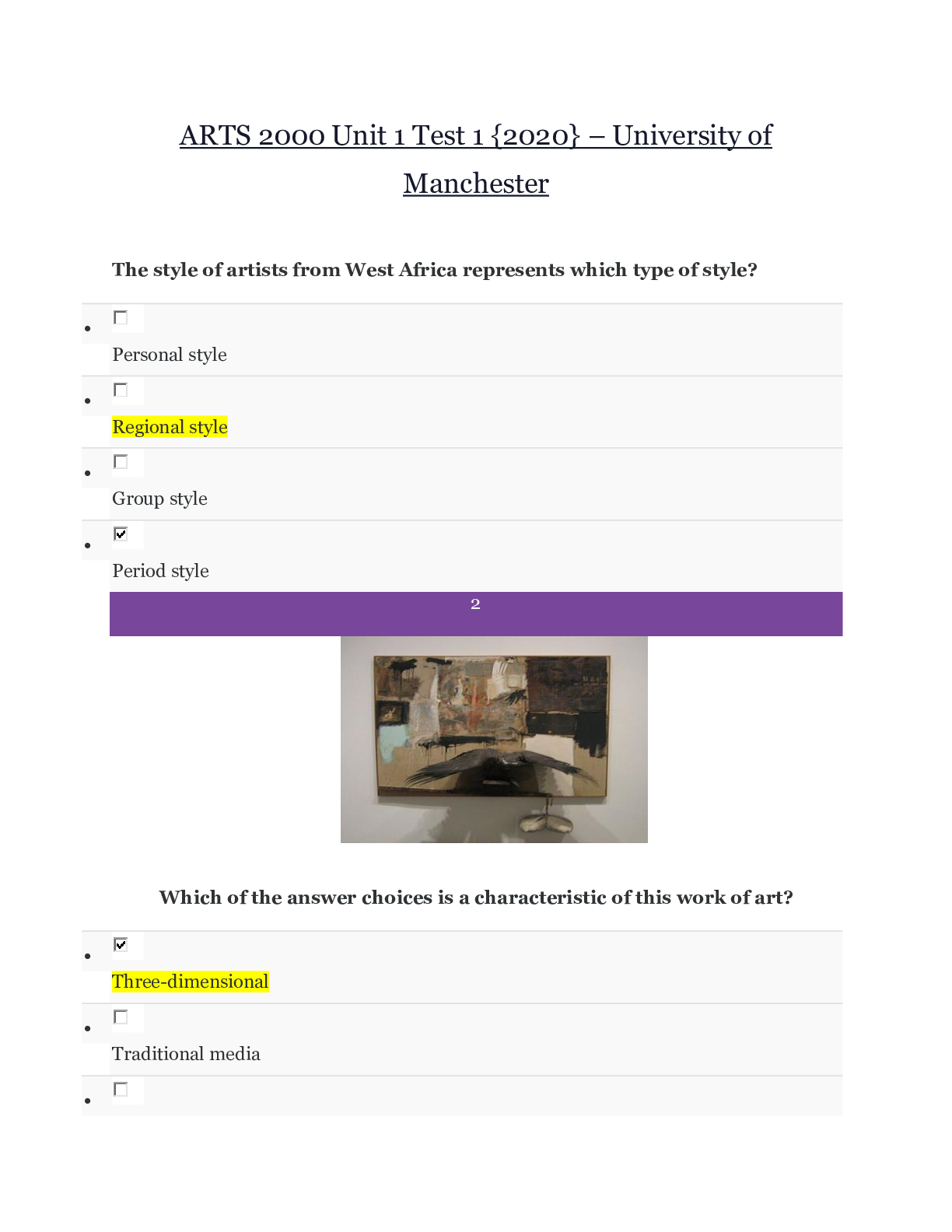Pharmacology > EXAM > NGR 6172 Pharmacology Midterm Exam {2020} – A Grade | NGR6172 Pharmacology Midterm Exam {2020} – (All)
NGR 6172 Pharmacology Midterm Exam {2020} – A Grade | NGR6172 Pharmacology Midterm Exam {2020} – University of Florida
Document Content and Description Below
- - - - - - - - - - - - - -- NGR 6172 Pharmacology Midterm Exam {2020} – University of Florida 1). A patient who takes daily doses of aspirin is scheduled for surgery next week... . The nurse should advise the patient to: a. continue to use aspirin as scheduled. b. reduce the aspirin dosage by half until after surgery. c. stop using aspirin immediately. d. stop using aspirin 3 days before surgery. C Aspirin must be withdrawn at least 1 week before surgery. Aspirin cannot be continued as scheduled, because the risk for bleeding is too great. An interval of 3 days is not long enough for the bleeding effects of aspirin to be reversed. Cutting the dose in half would not reduce the effects of bleeding associated with aspirin use. 2). A patient who takes aspirin for rheumatoid arthritis is admitted to the hospital complaining of headache and ringing in the ears. The plasma salicylate level is 300 mcg/mL, and the urine pH is 6.0. What will the nurse do? a. Increase the aspirin dose to treat the patient's headache. b. Notify the provider of possible renal toxicity. c. Prepare to provide respiratory support, because the patient shows signs of overdose. d. Withhold the aspirin until the patient's symptoms have subsided. D This patient shows signs of salicylism, which occurs when ASA levels climb just slightly above the therapeutic level. Salicylism is characterized by tinnitus, sweating, headache, and dizziness. Tinnitus is an indication that the maximum acceptable dose has been achieved. Toxicity occurs at a salicylate level of 400 mcg/mL or higher. ASA should be withheld until the symptoms subside and then should be resumed at a lower dose. Increasing the dose would only increase the risk of toxicity. Signs of renal impairment include oliguria and weight gain, which are not present in this patient. This patient has salicylism, not salicylate toxicity, so respiratory support measures are not indicated. 3). A pregnant patient asks the nurse if she can take antihistamines for seasonal allergies during her pregnancy. What will the nurse tell the patient? a. Antihistamines should be avoided unless absolutely necessary. b. Second-generation antihistamines are safer than first-generation antihistamines. c. Antihistamines should not be taken during pregnancy but may be taken when breast-feeding. d. The margin of safety for antihistamines is clearly understood for pregnant patients. A Antihistamines are pregnancy Category C, with debate currently occurring regarding degree of effects on the fetus. They should be avoided unless absolutely necessary. All antihistamines have adverse effects on the fetus. Antihistamines can be excreted in breast milk. The margin of safety of antihistamines in pregnancy is not clear, so these agents should be avoided unless a clear benefit of treatment outweighs any risks 4). A 5-year-old child with seasonal allergies has been taking 2.5 mL of cetirizine [Zyrtec] syrup once daily. The parents tell the nurse that the child does not like the syrup, and they do not think that the drug is effective. The nurse will suggest they discuss which drug with their child's healthcare provider? a. Cetirizine [Zyrtec] 5-mg chewable tablet once daily b. Loratadine [Claritin] 10-mg chewable tablet once daily c. Fexofenadine [Allegra] syrup 5 mL twice daily d. Desloratadine [Clarinex] 5-mg rapid-disintegrating tablet once daily A The child is receiving a low dose of cetirizine and can receive up to 5 mg per day in either a single dose or two divided doses. Cetirizine is available in a chewable tablet, which this child may tolerate better, so the parents should be encouraged to explore this option with their provider. The loratadine 10-mg chewable tablet is approved for children 6 years and older. Fexofenadine would be safe for this child, but it is unlikely that the syrup would be any better than the cetirizine syrup. Desloratadine is not approved for children under the age of 12 years. 5). A 1-year-old child is scheduled to receive the MMR vaccine, pneumococcal vaccine (PCV), Varivax, and hepatitis A vaccine. The child's parents request that the MMR vaccine not be given, saying that, even though there is no demonstrated link with autism, they are still concerned about toxic levels of mercury in the vaccine. Which response by the nurse is correct? a. "Most U.S.-made vaccines have zero to low amounts of mercury." b. "Other vaccine preparations contain mercury as well." c. "Thimerosal is a nontoxic form of mercury." d. "You can get more mercury from breast milk and many foods on the market." A Because of concerns about mercury levels, most U.S.-made vaccines contain either zero or very low amounts of mercury. Some multidose vials of flu vaccine still contain thimerosal, but even that is a very low amount. Telling parents that other vaccines contain mercury will increase their suspicion about vaccines and further reduce their trust. Thimerosal is a mercury-based preservative and thus has the same toxicity as mercury. Although it is true that mercury is found in breast milk and other foods, telling parents this belittles their concerns about the vaccines. 6). A patient with moderate to severe chronic pain has been taking oxycodone [OxyContin] 60 mg every 6 hours PRN for several months and tells the nurse that the medication is not as effective as before. The patient asks if something stronger can be taken. The nurse will contact the provider to discuss: a. administering a combination opioid analgesic/acetaminophen preparation. b. changing the medication to a continued-release preparation. c. confronting the patient about drug-seeking behaviors. d. withdrawing the medication, because physical dependence has occurred. B Oxycodone is useful for moderate to severe pain, and a continued-release preparation may give more continuous relief. Dosing is every 12 hours, not PRN. A combination product is not recommended with increasing pain, because the nonopioid portion of the medication cannot be increased indefinitely. This patient does not demonstrate drug-seeking behaviors. Physical dependence is not an indication for withdrawing an opioid, as long as it is still needed; it indicates a need for withdrawing the drug slowly when the drug is discontinued. 7). A patient will receive buprenorphine [Butrans] as a transdermal patch for pain. What is important to teach this patient about the use of this drug? a. Avoid prolonged exposure to the sun. b. Cleanse the site with soap or alcohol. c. Remove the patch daily at bedtime. d. Remove hair by shaving before applying the patch. A Patients using the buprenorphine transdermal patch should be cautioned against heat, heating pads, hot baths, saunas, and prolonged sun exposure. The skin should be cleaned with water only. The patch should stay on for 7 days before a new patch is applied. Patients should remove hair by clipping, not shaving. 8). A patient has been taking methadone [Dolophine] for 5 months to overcome an opioid addiction. The nurse should monitor the patient for which of the following electrocardiographic changes? a. Prolonged QT interval b. Prolonged P-R interval c. AV block d. An elevated QRS complex A Methadone prolongs the QT interval. It does not prolong the P-R interval, cause AV block, or produce an elevated QRS complex. 9). A patient taking fluoxetine [Prozac] complains of decreased sexual interest. A prescriber orders a "drug holiday." What teaching by the nurse would best describe a drug holiday? a. "Cut the tablet in half anytime to reduce the dosage." b. "Discontinue the drug for 1 week." c. "Don't take the medication on Friday and Saturday." d. "Take the drug every other day." C Sexual dysfunction may be managed by having the patient take a drug holiday, which involves discontinuing medication on Fridays and Saturdays. Cutting the tablet in half anytime to reduce the dosage is an inappropriate way to manage drug administration effectively. In addition, it does not describe a drug holiday. The patient should not take the drug every other day, nor should it be discontinued for a week at a time, because this would diminish the therapeutic levels of the drug, thereby minimizing the therapeutic effects. In addition, neither of those options describe a drug holiday. 10). A patient is diagnosed with major depression with severe symptoms and begins taking an antidepressant medication. Three weeks after beginning therapy, the patient tells the nurse that the drug is not working. The nurse will counsel this patient to ask the provider about: a. adding a second medication to complement this drug. b. changing the medication to one in a different drug class. c. increasing the dose of this medication. d. using nondrug therapies to augment the medication. D Patients with severe depression benefit more from a combination of drug therapy and psychotherapy than from either component alone, so this patient should ask the provider about nondrug therapies. Once a drug has been selected for treatment, it must be used for 4 to 8 weeks before its efficacy can be assessed. Until a drug has been used at least 1 month without success, it should not be considered a failure. Adding a second medication, changing to a different medication, and increasing the dose of this medication should all be reserved until the current drug is deemed to have failed after at least 4 weeks. - - - - - -- - - - - - - - - - - - - - - - - - - - - - - - - - - - - - - - 70). A patient has had blood pressures of 150/95 mm Hg and 148/90 mm Hg on two separate office visits. The patient reports a blood pressure of 145/92 mm Hg taken in an ambulatory setting. The patient's diagnostic tests are all normal. The nurse will expect this patient's provider to order: a. a beta blocker. b. a loop diuretic and spironolactone. c. a thiazide diuretic. d. counseling on lifestyle changes. C This patient has primary, or essential, hypertension as evidenced by systolic pressure greater than 140 and diastolic pressure greater than 90, along with normal tests ruling out another primary cause. Thiazide diuretics are first-line drugs for hypertension. Beta blockers are effective but are most often used to counter reflex tachycardia associated with reduced blood pressure caused by therapeutic agents. Loop diuretics cause greater diuresis than is usually needed and so are not first-line drugs. This patient should be counseled on lifestyle changes as an adjunct to drug therapy but should also begin drug therapy because hypertension already exists. 71). A patient with diabetes develops hypertension. The nurse will anticipate administering which type of medication to treat hypertension in this patient? a. ACE inhibitors b. Beta blockers c. Direct-acting vasodilators d. Thiazide diuretics A ACE inhibitors slow the progression of kidney injury in diabetic patients with renal damage. Beta blockers can mask signs of hypoglycemia and must be used with caution in diabetics. Direct-acting vasodilators are third-line drugs for chronic hypertension. Thiazide diuretics promote hyperglycemia. 72). A patient who does not consume alcohol or nicotine products reports a strong family history of hypertension and cardiovascular disease. The patient has a blood pressure of 126/82 and a normal weight and body mass index for height and age. The nurse will expect to teach this patient about: a. ACE inhibitors and calcium channel blocker medications. b. the DASH diet, sodium restriction, and exercise. c. increased calcium and potassium supplements. d. thiazide diuretics and lifestyle changes. B This patient has prehypertension without other risk factors. Lifestyle changes are indicated at this point. If blood pressure rises to hypertension levels, other measures, including drug therapy, will be initiated. Calcium and potassium supplements are not indicated. 73). A nursing student asks the nurse why multi-drug therapy is often used to treat hypertension. Which statement by the student indicates a need for further teaching? a. "Multi-drug therapy often means that drugs may be given in lower doses." b. "Some agents are used to offset adverse effects of other agents." c. "Treatment of hypertension via different mechanisms increases success." d. "Two or more drugs will lower blood pressure more quickly." D Multi-drug therapy does not lower blood pressure more quickly. Using more than one drug often means that doses can be decreased. Some agents can offset adverse effects of other agents. Treatment via different mechanisms increases the likelihood of success. 74). A female patient with essential hypertension is being treated with hydralazine 25 mg twice daily. The nurse assesses the patient and notes a heart rate of 96 beats per minute and a blood pressure of 110/72 mm Hg. The nurse will request an order to: a. administer a beta blocker. b. administer a drug that dilates veins. c. reduce the dose of hydralazine. d. give the patient a diuretic. A This patient is showing signs of reflex tachycardia, so a beta blocker is indicated to slow the heart rate. Patients with heart failure who take hydralazine often require the addition of isosorbide dinitrate, which also dilates veins. There is no indication for reducing the dose of hydralazine. A diuretic can be given with hydralazine if sodium and water retention is present. 75). A patient is admitted with severe hypertensive crisis. The nurse will anticipate administering which medication? a. Captopril PO b. Hydralazine [Apresoline] 25 mg PO c. Minoxidil 20 mg PO d. Sodium nitroprusside [Nitropress] IV D Sodium nitroprusside is the drug of choice for hypertensive emergencies and is given intravenously. ACE inhibitors, such as captopril, are not used. Hydralazine may be used but should be given IV. Minoxidil is effective, but its severe side effects make it a second-line drug. 76). A hospitalized patient complains of acute chest pain. The nurse administers a 0.3-mg sublingual nitroglycerin tablet, but the patient continues to complain of pain. Vital signs remain stable. What is the nurse's next step? a. Apply a nitroglycerin transdermal patch. b. Continue dosing at 10-minute intervals. c. Give a second dose of nitroglycerin in 5 minutes. d. Request an order for intravenous nitroglycerin. C An initial dose of sublingual nitroglycerin is taken, and if the chest pain persists, as in this case, the patient should take another dose in 5 minutes. Transdermal delivery systems are not useful for terminating an ongoing attack. Dosing at 10-minute intervals is incorrect. If the patient fails to respond or if the pain intensifies, intravenous nitroglycerin may be indicated. 77). A 60-year-old female patient is about to begin long-term therapy with a glucocorticoid. Which of the following will be important for minimizing the risk of osteoporosis? a. Baseline vitamin D level b. Calcium and vitamin D supplements c. Estrogen therapy d. Skeletal x-rays before treatment B Calcium and vitamin D supplements can help minimize the patient's risk of developing osteoporosis. A baseline vitamin D level is not recommended. Estrogen therapy can help in postmenopausal women, but its risks outweigh its benefits. Patients should undergo evaluation of the bone mineral density of the lower spine, not skeletal x-rays. 78). A patient with type 1 diabetes reports mixing NPH and regular insulin to allow for one injection. What should the nurse tell the patient? a. This is an acceptable practice. b. These two forms of insulin are not compatible and cannot be mixed. c. Mixing these two forms of insulin may increase the overall potency of the products. d. NPH insulin should only be mixed with insulin glargine. A NPH insulin is the only insulin suitable for mixing with short-acting insulins, such as insulin aspart [NovoLog]. These insulins are compatible and are mixed frequently for management of diabetics. The overall potency of each insulin is not increased by mixing them. Insulin glargine cannot be mixed with any other insulin for administration. 79). A nurse is teaching a patient who has been diagnosed with hypothyroidism about levothyroxine [Synthroid]. Which statement by the patient indicates a need for further teaching? a. "I should not take heartburn medication without consulting my provider." b. "I should report insomnia, tremors, and an increased heart rate to my provider." c. "If I take a multivitamin with iron, I should take it 4 hours after the Synthroid." d. "If I take calcium supplements, I may need to decrease my dose of Synthroid." D Patients taking calcium supplements should take these either 4 hours before or after taking levothyroxine, because they interfere with levothyroxine absorption. Many heartburn medications contain calcium, so patients should consult their provider before taking them. Insomnia, tremors, and tachycardia are signs of levothyroxine toxicity and should be reported. Iron also interferes with levothyroxine absorption, so dosing should be 4 hours apart. 80). A nurse is teaching a patient who will begin taking methimazole [Tapazole] for Graves' disease about the medication. Which statement by the patient indicates understanding of the teaching? a. "Because of the risk for liver toxicity, I will need frequent liver function tests." b. "I should report a sore throat or fever to my provider if either occurs." c. "I will need a complete blood count every few months." d. "It is safe to get pregnant while taking this medication." B Agranulocytosis is rare but can occur with methimazole, so patients should report signs of infection, such as a sore throat or fever. Liver toxicity is not a side effect, so liver function tests are not indicated. Because agranulocytosis often develops rapidly, periodic blood counts do not guarantee early detection. Methimazole is contraindicated in the first trimester of pregnancy. ** Diabetic lost his job and no longer able to pay for his medications **Old people physiological changes = Frequent Hepatic drug dosing ** Full prescriptive authority = More patients will have access to health care ** Patient switched from Subutrex to suboxone = Less likely to be abused ** How does Narcan work? **Patient experiencing euphoria for the first time = lithium **What organ does a beta (1) agonist primarily target? **A woman in premature labor, what drug would you expect to give? [Show More]
Last updated: 2 years ago
Preview 1 out of 36 pages

Buy this document to get the full access instantly
Instant Download Access after purchase
Buy NowInstant download
We Accept:

Reviews( 0 )
$14.50
Can't find what you want? Try our AI powered Search
Document information
Connected school, study & course
About the document
Uploaded On
Feb 11, 2021
Number of pages
36
Written in
Additional information
This document has been written for:
Uploaded
Feb 11, 2021
Downloads
0
Views
87








 – University of the People.png)




